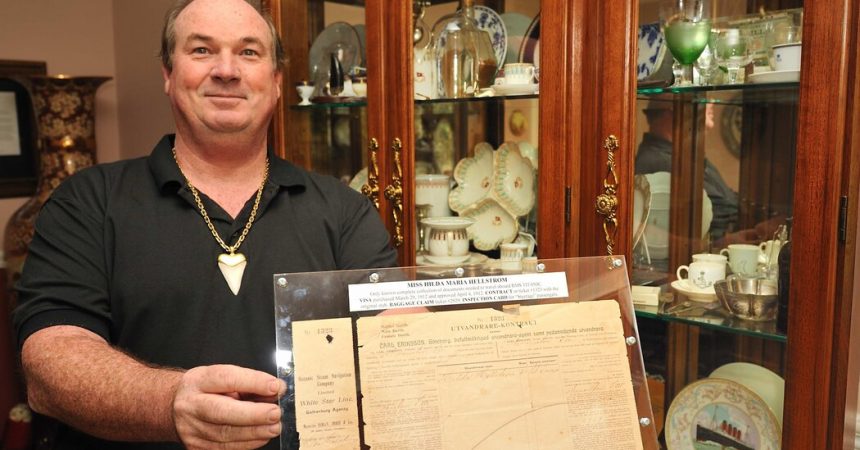Tony Probst’s passion for the Titanic is unwavering.
Since the mid-1990s, he has amassed hundreds of artifacts from the ship’s maiden voyage in 1912, including a lifeboat plaque, china, sheet music and an array of personal documents.
“I believe I’m the only person on planet Earth who has every piece of paper for one individual to get on board Titanic,” Mr. Probst, 64, said proudly this week.
His collection is sometimes on display at the audio and visual store he runs with his sons in the Bay Area of California, but it has also toured prominent spaces, including the National Geographic Museum in Washington; the Ronald Reagan Presidential Library and Museum in Simi Valley, Calif.; and the Titanic museums in Branson, Mo., and Pigeon Forge, Tenn.
Mr. Probst’s enthusiasm for the Titanic — which puts him somewhere between a collector and historian, he said — makes him part of a small but zealous community seeking out memorabilia from the ship, which sank after striking an iceberg in the North Atlantic Ocean, killing 1,500 people.
Henry Aldridge & Son Ltd, an auction house in southwest England, will host an auction on Saturday of Titanic and other shipping and transport memorabilia. Among the more than 250 items for sale is a black-and-white photograph of an iceberg taken by a member of a body recovery ship after the disaster and the violin case of the bandleader Wallace Hartley, which is expected to fetch up to 120,000 pounds, or about $150,000. (The violin sold in 2013 for £1.1 million, or about $1.3 million.)
The reasons for seeking out items from the Titanic vary widely, but for Mr. Probst it is the stories about the victims and survivors that motivate him to keep collecting and to keep an eye on auctions.
“There’s a few people out there with very, very deep pockets and, you know, nowadays they get all the prime pieces,” Mr. Probst said. “I’m not in that category. I’m really more into preserving stories.”
Mr. Probst, who said he was recuperating from a couple of big purchases, does not have anything on his wish list at the moment but planned to study the auction catalog anyway.
“I really want to go after things that I want,” he said, or items that he could lease to museums.
“I call it my retirement account, in a way, because I get the principle and that goes up in value,” he added. “But in the meantime, I get to lease it out and make a little money.”
Henry Aldridge & Son has been holding Titanic-themed sales biannually since the late 1990s, according to Andrew Aldridge, the managing director of the auction house. Mr. Aldridge said bidders often had their own niches and individual motivations.
“Some just collect Titanic memorabilia, per se,” he said. “But others go a little bit deeper and they work into specifics. Specific passengers, specific classes. People that come from specific areas. We’ll have people that just collect things from Scandinavian passengers.”
The Titanic-collecting community is fairly small, particularly at the higher end of purchases, said David Scott-Beddard, chairman of the British Titanic Society. Competition for hot-ticket items can sometimes be fierce. “To a certain extent, it’s how much do I want it and how much am I prepared to spend on it — without the wife finding out,” he said.
There was not much concern over items disappearing from the public view after being purchased, Mr. Scott-Beddard added. He said the community was very fortunate that a majority of collectors, even those shopping at the six- and seven-figure levels, were generous enough to allow their pieces to be displayed for the general public.
“Titanic is probably, next to Noah’s ark, history’s most famous ship,” said Charles Haas, president of the Titanic International Society. Some enthusiasts are driven by the search for increasingly rare artifacts carried off the ship by passengers, others by psychological connections that collectors sometimes make, viewing the disaster through the eyes of victims and survivors.
Mr. Haas said he was unsure whether a day would come when demand for Titanic items waned.
“The Titanic story has already lasted 112 years,” he said. “And while there are people out there who say, ‘The ship sank, get over it,’ it has so much built-in drama to it that the younger generations are still quite fascinated by it.”
Mr. Haas hopes that they will carry on in the footsteps of current collectors, who Mr. Aldridge says are merely the temporary custodians of the artifacts.
“The best way to describe it is: You never own these objects,” Mr. Aldridge said. “Your job is to hold onto to them for as long as they’re in your possession. Keep them safe and then pass them forward to the next generation, the next individual, the next collector.”







